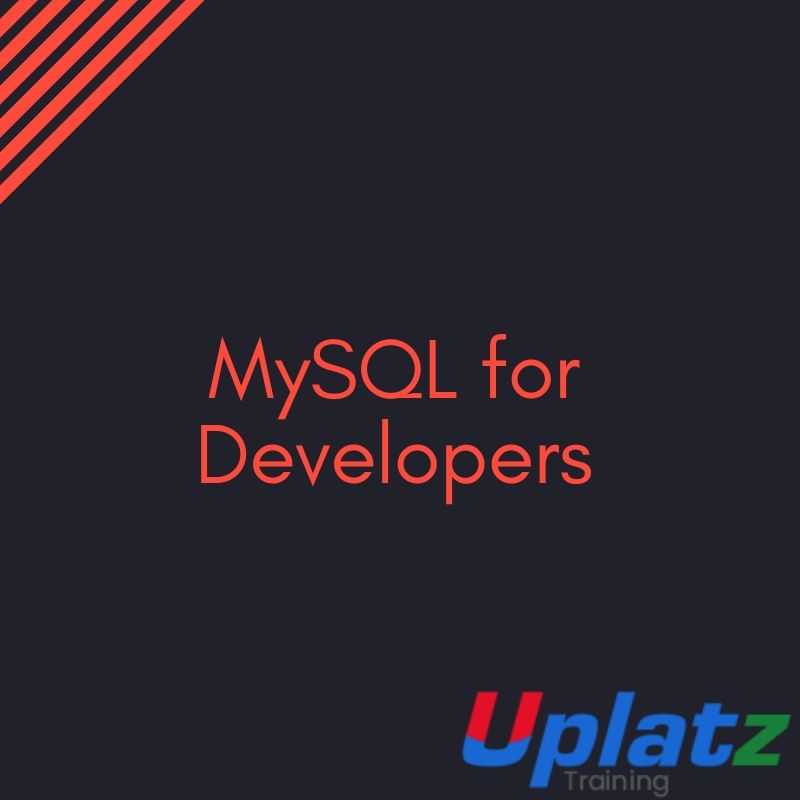MySQL for Developers

MySQL for Developers Course Overview
This MySQL Developers training course is designed for MySQL Developers who have a good understanding of a MySQL database and experience of using SQL commands. The course provides further practical experience in more advanced MySQL commands and SQL statements including regular expression support, Common Table Expressions, Window functions, Stored Routines, custom functions, exception handling and Triggers.
-----------------------------------------------------------------------------------------------------------------------
Who will the Course Benefit?
MySQL Developers who have a basic understanding of a MySQL database and SQL commands as covered on the Introduction to MySQL course.
---------------------------------------------------------------------------------------------------------------------
Course Objectives
To provide the skills needed to write more advanced queries and database maintenance statements on a MySQL database.
-----------------------------------------------------------------------------------------------------------------------
This is a MySQL for Developers course by Uplatz.
MySQL for Developers
MySQL for Developers Training Course
Course Introduction
- Administration and Course Materials
- Course Structure and Agenda
- Delegate and Trainer Introductions
Session 1: CLIENT/SERVER CONCEPTS
- MySQL client/server architecture
- Server modes
- Using client programs
- Logging in options
- Configuration files
- Precedence of logging in options
- Exercises: Using client/server
Session 2: THE MYSQL CLIENT PROGRAM
- Using MySQL interactively
- The MySQL prompts
- Client commands and SQL statements
- Editing
- Selecting a database
- Help
- Safe updates
- Using script files
- Using a source file
- Redirecting output into a file
- Command line execution
- Mysql output formats
- Overriding the defaults
- Html and xml output
- MySQL Utilities
- Exercises: Using the MySQL client program
Session 3: DATA TYPES
- Bit data type
- Numeric data types
- Auto_increment
- Character string data types
- Character sets and collation
- Binary string data types
- Enum and Set data types
- Temporal data types
- Timezone support
- Spatial Datatypes
- Handling Missing Or Invalid Data Values
- SQL_MODE options
- Exercises: Using data types
Session 4: IDENTIFIERS
- Using Quotes with identifier naming
- Case sensitivity in Identifier naming
- Qualifying columns with table and database names
- Using reserved words as identifiers
- Function names
- Exercises: Using identifiers
Session 5: QUERYING FOR DATA
- The SQL select statement and MySQL differences
- Advanced order by
- Order by and collation
- Order by with enum datatype
- Order by with Set datatype
- Ordering with distinct and group by
- Special features of union
- Limit and order by clauses
- Group By clause
- Group_concat
- Using Rollup in a Group By clause
- Exercises: Querying for data
MySQL for Developers Training Course
Session 6: SQL EXPRESSIONS AND FUNCTIONS
- Components of expressions
- Nulls
- Numeric expressions
- String expressions
- Temporal expressions
- Comparison functions
- Flow control functions
- Numeric functions
- String functions
- Temporal functions
- Exercises: Using expressions and functions
Session 7: UPDATING DATA
- Update operations and privileges
- Inserting rows
- Insert using a set clause
- Inserting duplicate values
- Replacing rows
- Updating rows
- Update using the order by and limit clauses
- Deleting rows
- The delete and truncate statements
- Exercise: Inserting, updating, replacing and deleting data
Session 8: CONNECTORS
- MySQL client interfaces
- MySQL connectors
- Oracle and community conectors
- Connecting to MySQL server using Java and PHP connectors
- MySQL and NoSQL
- Innodb integration with memcached
Session 9: OBTAINING DATABASE METADATA
- What is metadata?
- Using mysqlshow utility with MariaDB
- The show and describe commands
- Describing tables
- The information_schema
- Listing tables
- Listing columns
- Listing views
- Listing key_columns_usage
- Exercises: Obtaining database metadata
Session 10: DEBUGGING
- MySQL error messages
- The show statement
- Show errors
- Show count(*) errors
- Show warnings
- Show count(*) warnings
- Note messages
- The perror utility
- Exercises: Debugging
MySQL for Developers Training Course
Session 11: IMPORT AND EXPORT
- Exporting using SQL
- Privileges required to export data
- Importing using SQL
- Messages when loading data
- Privileges required to load data
- Exporting from the command line
- Mysqldump main options
- Importing from the command line
- Mysqlimport main options
- Exercises: Importing and exporting
Session 12: SUBQUERIES
- Types of subquery
- Multiple-column subqueries
- Correlated subqueries
- Using the ANY, ALL and SOME operators
- Using the EXISTS operator
- Subqueries as scalar expressions
- Derived Table
- WITH Clause ( Common Table Expression - CTE )
- Recursive CTEs
- Using subqueries in updates and deletes
- Exercises: Coding subqueriess
Session 13: VIEWS
- Why views are used
- Creating views
- View creation restrictions
- View algorithms
- Updateable views
- Altering and dropping views
- Displaying information about views
- Privileges for views
- Exercises: Using views
Session 14: USING WINDOW FUNCTIONS
- Description
- Non-aggregate window functions
- Using RANK, DENSE_RANK, ROW_NUMBER, NTILE
- Window partition clause
- Using LAG. LEAD, FIRST_VALUE, LAST_VALUE, NTH_VALUE
- Aggregate window functions - SUM, AVG etc
- Window frame clause
- Exercises: Using Window Functions
Session 15: REGULAR EXPRESSION SUPPORT
- Overview of Regular Expression
- Regular Expression Notation
- The REGEXP_LIKE operator
- The REGEXP_INSTR function
- The REGEXP_SUBSTR function
- The REGEXP_INSTR function
- The REGEXP_REPLACE function
- Exercises: Regular Expression Support
MySQL for Developers Training Course
Session 16: USER VARIABLES AND PREPARED STATEMENTS
- Creating User variables
- User variables in a select
- Prepared statements
- The prepare statement
- The execute statement
- The deallocate statement
- Using prepared statements in code, with connectors
- Exercises: Using variables and prepared statements
Session 17: INTRODUCTION TO STORED ROUTINES
- Types of stored routines
- Benefits of stored routines
- Stored routine features
- Differences between procedures and functions
- Introduction to the Block
- Declaring variables and constants
- Assigning values to variables
- Definer rights and invoker rights
- Using SELECT in stored routines
- Altering and dropping stored routines
- Obtaining stored routine metadata
- Stored routine privileges and execution security
- Exercises: Writing simple stored routines
Session 18: STORED ROUTINES - PROGRAM LOGIC
- The IF .. THEN .. ELSEIF construct
- The CASE statement
- The basic loop
- The while loop
- The repeat loop
- The iterate statement
- Nested loops
- Exercises: Writing stored routines with program logic
Session 19: PROCEDURES WITH PARAMETERS
- Creating procedures with parameters
- Calling Procedures With Parameters
- Exercises: Writing stored routines with parameters
MySQL for Developers Training Course
Session 20: STORED ROUTINES - EXCEPTION HANDLERS & CURSORS
- Dealing with errors using Exception handlers
- Cursors
- What is a cursor?
- Cursor operations
- Declaring cursors
- Opening and closing cursors
- Fetching rows
- Status checking
- Exercises: Writing stored routines with program logic
Session 21: FUNCTIONS
- What is a function?
- The create function statement
- Executing functions
- Executing functions from code
- Executing functions from SQL statements
- The deterministic and SQL clauses
- Exercises: Writing functions
Session 22: TRIGGERS
- Trigger creation
- Restrictions on triggers
- The create trigger statement
- Using the old and new qualifiers
- Managing triggers
- Destroying triggers
- Required privileges
- Exercises: Writing triggers
Session 23: BASIC OPTIMIZATIONS
- Normalisation of data to third normal form
- Using indexes for optimization
- General query enhancement
- Using Explain to analyze queries
- Choosing an INNODB or MYISAM storage engine
- Using MySQL Enterprise Monitor in query optimization
- Exercises: Making use of basic optimizations
Session 24: MORE ABOUT INDEXES
- Indexes and joins
- Exercises: Investigating indexes and joins
Together with the Introduction to MySQL course, the content of this MySQL for Developers course will teach the major topics required for the delegate to work towards achieving the MySQL 5.6 Developer Certified Professional Exam(1Z0-882).
Before taking any exam, ensure you have the recommended experience. The Oracle website lists all exam requirements and these are updated regularly.
Exams are not included as part of the course.








